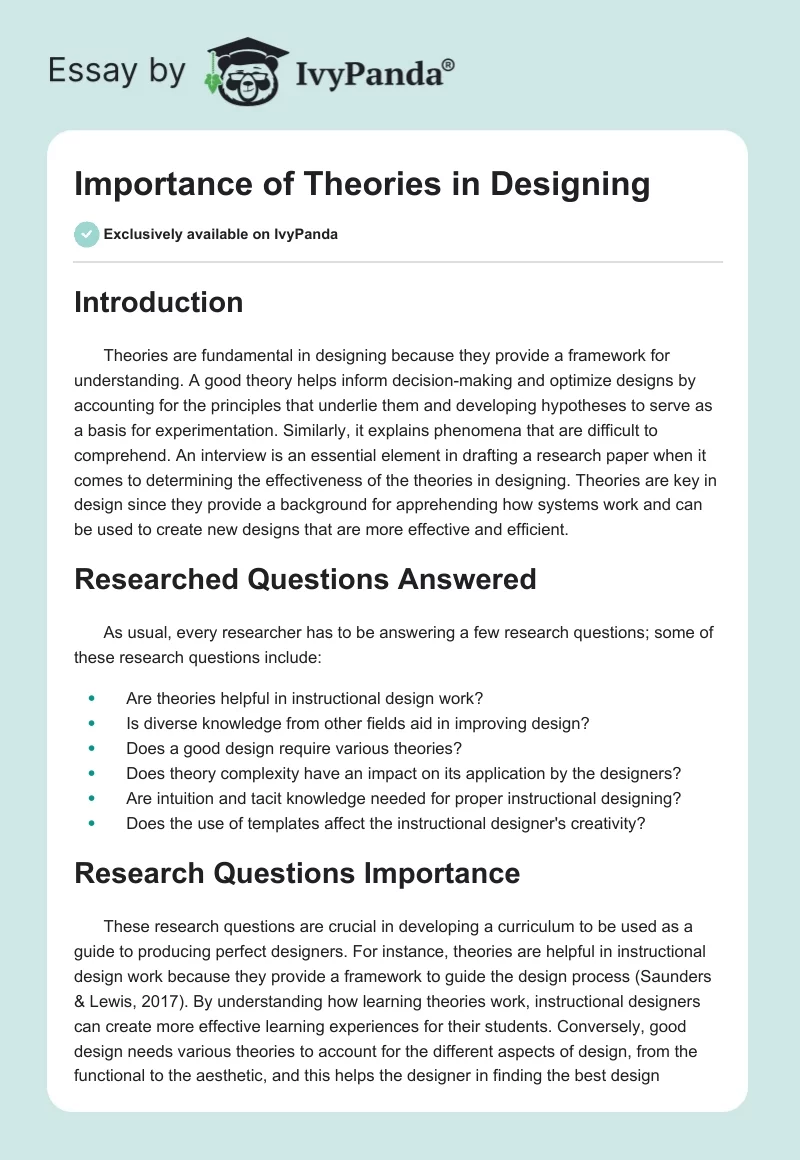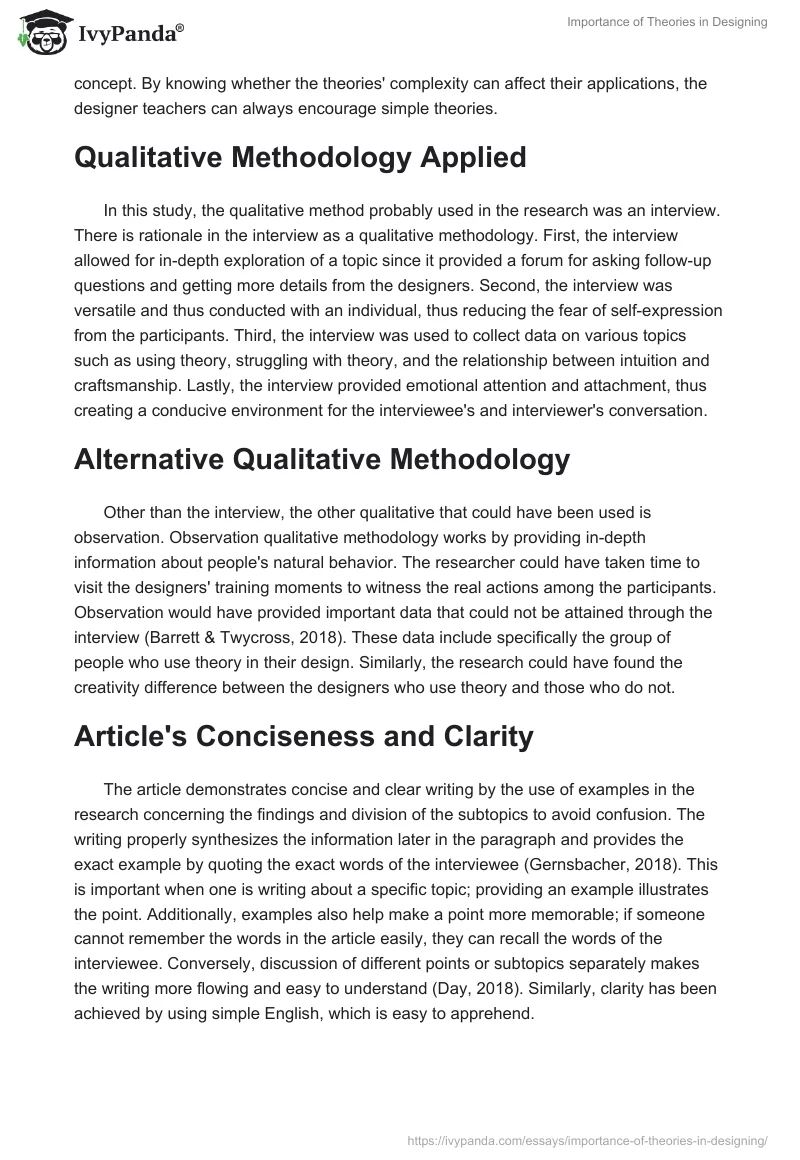Introduction
Theories are fundamental in designing because they provide a framework for understanding. A good theory helps inform decision-making and optimize designs by accounting for the principles that underlie them and developing hypotheses to serve as a basis for experimentation. Similarly, it explains phenomena that are difficult to comprehend. An interview is an essential element in drafting a research paper when it comes to determining the effectiveness of the theories in designing. Theories are key in design since they provide a background for apprehending how systems work and can be used to create new designs that are more effective and efficient.
Researched Questions Answered
As usual, every researcher has to be answering a few research questions; some of these research questions include:
- Are theories helpful in instructional design work?
- Is diverse knowledge from other fields aid in improving design?
- Does a good design require various theories?
- Does theory complexity have an impact on its application by the designers?
- Are intuition and tacit knowledge needed for proper instructional designing?
- Does the use of templates affect the instructional designer’s creativity?
Research Questions Importance
These research questions are crucial in developing a curriculum to be used as a guide to producing perfect designers. For instance, theories are helpful in instructional design work because they provide a framework to guide the design process (Saunders & Lewis, 2017). By understanding how learning theories work, instructional designers can create more effective learning experiences for their students. Conversely, good design needs various theories to account for the different aspects of design, from the functional to the aesthetic, and this helps the designer in finding the best design concept. By knowing whether the theories’ complexity can affect their applications, the designer teachers can always encourage simple theories.
Qualitative Methodology Applied
In this study, the qualitative method probably used in the research was an interview. There is rationale in the interview as a qualitative methodology. First, the interview allowed for in-depth exploration of a topic since it provided a forum for asking follow-up questions and getting more details from the designers. Second, the interview was versatile and thus conducted with an individual, thus reducing the fear of self-expression from the participants. Third, the interview was used to collect data on various topics such as using theory, struggling with theory, and the relationship between intuition and craftsmanship. Lastly, the interview provided emotional attention and attachment, thus creating a conducive environment for the interviewee’s and interviewer’s conversation.
Alternative Qualitative Methodology
Other than the interview, the other qualitative that could have been used is observation. Observation qualitative methodology works by providing in-depth information about people’s natural behavior. The researcher could have taken time to visit the designers’ training moments to witness the real actions among the participants. Observation would have provided important data that could not be attained through the interview (Barrett & Twycross, 2018). These data include specifically the group of people who use theory in their design. Similarly, the research could have found the creativity difference between the designers who use theory and those who do not.
Article’s Conciseness and Clarity
The article demonstrates concise and clear writing by the use of examples in the research concerning the findings and division of the subtopics to avoid confusion. The writing properly synthesizes the information later in the paragraph and provides the exact example by quoting the exact words of the interviewee (Gernsbacher, 2018). This is important when one is writing about a specific topic; providing an example illustrates the point. Additionally, examples also help make a point more memorable; if someone cannot remember the words in the article easily, they can recall the words of the interviewee. Conversely, discussion of different points or subtopics separately makes the writing more flowing and easy to understand (Day, 2018). Similarly, clarity has been achieved by using simple English, which is easy to apprehend.
Three Questions to be Anticipated by the Researcher
The researcher should anticipate three major questions being asked by other scholars. The first question to ask is what learning theory the instructional designer wants to use. There are a few popular theories, such as behaviorism, constructivism, and cognitive learning theory (Mattar, 2018). Each has its own set of assumptions about how people learn and the best ways to facilitate learning. Finally, another scholar may ask about the other qualitative methodology apart from the interview and compare whether they both produce the same and trustworthy results.
Findings and Knowledge Furthering
The findings of this research might further knowledge by providing insight on how the designers can be supported. Knowing and understanding what the designers prefer when it comes to reading theory, it becomes easier to design a better design plan for them. For example, Camille confirmed that having different sources help in finding the best information (Yanchar et al., 2010). And from this, the designing teachers advise learners to have various sources.
Alternation Research Questions Investigation
Another alternative way to investigate the research questions is through focus groups. A focus group is a discussion among a small number of people, usually about 8-10, who are asked about their specific opinions about theory in instructional design (Guest et al., 2017). It is different from the interview, which only involved one person at a time. With a focus group, the researcher is likely to get accurate results since the response will be based on the agreed fact of all members.
Conclusion
In conclusion, the research sought to answer five questions; the first and the main question was whether theories are important in designing. Theories are indeed crucial in making design decisions; Camille confirmed that theories are significant and used in their day-to-day designing activity. Regarding the second question, the interviewee (Camille) asserted that diverse sources are needed for making decisions. Similarly, Michelle also approved that different sources are the best since they help the designers in selecting the best ideas, thus forming a good design.
It is also a fact that complex theoretical concepts are not good for designers since they are hard to implement. As Yvette confirmed, design templates should only be used as a design guide, and designers still need to use their intuitions and creativity to produce a better design. All the research questions are vital for they can be used to formulate a better theory version for the designers. In the research, the interview was applied; it critically provided one on one interaction that made the session friendly for interviewees’ participation. Based on the validity of the results, other scholars may request to know if the same data could be found if other qualitative methodologies were applied.
References
Barrett, D., & Twycross, A. (2018). Data collection in qualitative research. Evidence-Based Nursing, 21(3), 63-64.
Day, T. (2018). Success in academic writing. Bloomsbury Academic.
Gernsbacher, M. A. (2018). Writing empirical articles: Transparency, reproducibility, clarity, and memorability. Advances in Methods and Practices in Psychological Science, 1(3), 403-414.
Guest, G., Namey, E., Taylor, J., Eley, N., & McKenna, K. (2017). Comparing focus groups and individual interviews: findings from a randomized study. International Journal of Social Research Methodology, 20(6), 693-708.
Mattar, J. (2018). Constructivism and connectivism in education technology: Active, situated, authentic, experiential, and anchored learning. RIED. Revista Iberoamericana de Educación a Distancia.
Saunders, M., & Lewis, P. (2017). Doing research in business and management. Pearson.
Yanchar, S. C., South, J. B., Williams, D. D., Allen, S., & Wilson, B. G. (2010). Struggling with theory? A qualitative investigation of conceptual tool use in instructional design. Educational Technology Research and Development, 58(1), 39-60.


